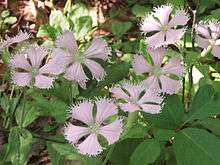Silene polypetala
| Silene polypetala | |
|---|---|
 | |
| Scientific classification | |
| Kingdom: | Plantae |
| (unranked): | Angiosperms |
| (unranked): | Eudicots |
| (unranked): | Core eudicots |
| Order: | Caryophyllales |
| Family: | Caryophyllaceae |
| Genus: | Silene |
| Species: | S. polypetala |
| Binomial name | |
| Silene polypetala (Walter) Fernald & B.G.Schub. | |
| Synonyms | |
|
Silene catesbaei | |
Silene polypetala (syn. Silene catesbaei) is a rare species of flowering plant in the pink family known by the common names eastern fringed catchfly[1] and fringed campion. It is native to Georgia and northern Florida in the United States. It is threatened by the loss and degradation of its habitat.[2] It is a federally listed endangered species of the United States.
This plant is a rhizomatous perennial herb growing from a thick taproot topped with a woody, branching caudex. There are several stems and shoots measuring up to 40 centimeters in length. The lance-shaped leaves are each up to 9 centimeters long by 25 wide and grow in pairs along the stem. The inflorescence usually has three flowers. Each flower has five pink or white fan-shaped petals with fringed tips, each measuring 1.5 to 2.5 centimeters long. The base of the flower is encased in a papery 10-veined calyx of sepals.[3] The plant can reproduce vegetatively by resprouting from its rhizome, so what appears to be several plants may be one plant with genetically identical clones.[2]
This plant grows in soils of sandy, calcareous loam, often in moist habitat in forests and woods.[2]
The main threat to the species is the loss of its habitat. In Georgia some populations have been endangered from logging and excavation activities, resulting in habitat fragmentation. The introduced species English ivy (Hedera helix) has invaded one population. Other invasive plant species include Japanese honeysuckle (Lonicera japonica), Chinese privet (Ligustrum sinense), spiceberry (Ardisia crenata), heavenly bamboo (Nandina domestica), and golden bamboo (Phyllostachys aurea). Though some populations have been destroyed, some new ones have been discovered in the meantime.[2]
References
- ↑ "Silene polypetala". Natural Resources Conservation Service PLANTS Database. USDA. Retrieved 15 November 2015.
- 1 2 3 4 Silene polypetala. The Nature Conservancy.
- ↑ Silene polypetala. Flora of North America.
